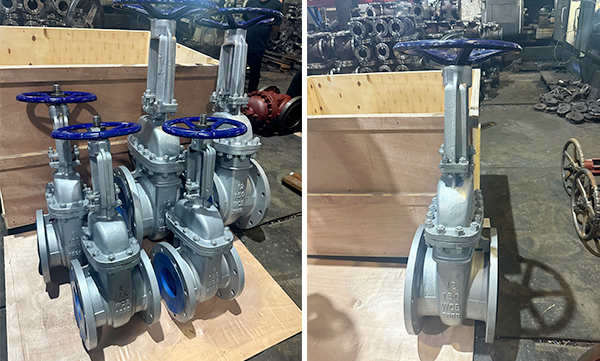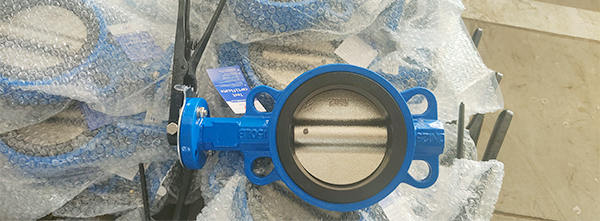- Gate valve
-
- DN1000 Extension stem double flange soft seal gate valveDIN F4 resilient seated gate valveDN450-1200 Resilient Seated Gate ValveDIN F5 resilient seated gate valveSocket connection soft seal gate valveUnderground cap soft seal gate valveBS5163 rising stem soft seal gate valveHard seal gate valveAPI slab Gate ValveStainless steel flange gate valveWafer knife gate valvePneumatic gate valveSoft seal gate valveExtension stem gate valveUL/FM fire protection groove ends gate valveRising stem forged steel gate valvecarbon steel gate valveStainless steel threaded gate valveDIN soft seal gate valveANSI soft sealing gate valve 200PSICast iron gate valveBS resilient seated gate valve
- Butterfly valve
-
- DN900 pneumatic triple eccentric hard seal butterfly valveD643H Triple Eccentric Butterfly ValveD343H Hard seal butterfly valveMulti standard EPDM seated butterfly valveSingle flange butterfly valveDN2000 Double eccentric butterfly valveFlange butterfly valveLug butterfly valveWafer butterfly valve with handleWorm gear operated butterfly valveWafer lined fluorine butterfly valveStainless steel wafer butterfly valveStainless steel flanged butterfly valveThree eccentric flange butterfly valvePneumatic flanged butterfly valvePneumatic wafer butterfly valveTriple eccentric butterfly valve wafer typeWafer butterfly valve ULC approvedInflatable seat butterfly valveHigh performance butterfly valveGrooved end butterfly valveElectric soft seal butterfly valveFlange fluorine lined butterfly valveHandle aluminum butterfly valveWorm Gear Aluminum Butterfly ValveFull PTFE lined butterfly valve wafer typeOne stem no-pin wafer butterfly valveMulti standard aluminum stem butterfly valveStainless Steel wafer Butterfly ValveAluminium handle operated lug butterfly valveLever Operated Flange Butterfly ValveButterfly valve stemButterfly valve discButterfly valve seat
- Ball valve
-
- DN1400 top-mounted eccentric semi-ball valveFlanged three-way ball valveFully welded ball valveNatural gas ball valveHigh platform flange ball valve1 PC ball valveFixed ball valvePTFE seat flanged ball valveMetal seat ball valveAPI 6D ball valve3 Piece ball valveFull Bore 3 way ball valve L-Port3 Way T-Port ball valve2PC Ball valve female thread stainless steel
- Globe Valve
-
- API Carbon Steel Globe ValveBellows Globe ValveStainless steel flange globe valveStainless steel thread S type globe valveStainless steel thread B type globe valveCast Steel Globe ValvePiston Globe ValveWCB Carbon Steel Globe Check Valveelectric motorized control stainless steel SS316 globe valveBrass Globe ValveCryogenic Globe valveHT200 Globe ValveThreaded Stainless Steel Globe ValveGG25 Globe ValveANSI API Cast Steel And Stainless Steel Globe valve
- Check valve
-
- Rubber seal check valveDN800 Slow closing check valveDN800 Rubber Disc Check ValveButterfly Buffering Check Valvecheck valve with counter weightSilent Check ValveWCB Swing check valveSwing Check ValveSingle Chip Check Valve H74WStainless Steel Wafer Check ValveSwing Start Check ValveFoot check valveAPI Swing Check ValveDIN Flange check valveSingle plate check valveLifting Check ValveBottom ValveHammer Diminish Noises Check ValveWafer Check ValveWafer dual plate check valve
- Control valve
-
- Static Balancing ValveCage Guided Sleeve Globe Control ValveDN1000 Piston Flow Regulating ValveDN1600 Electric Actuator Flow Regulating ValvePneumatic Flanged Butterfly ValvePneumatic Wafer Butterfly ValveAngle Seat ValvePneumatic gate valveElectric three-way control valveElectric sleeve control valve
- Water Meter
-
- Vertical Type Water MetersStainless steel threaded water meterPiston water meterPlastic water meterMore flow rotor dry water meterspiral vane flange water meterCI wotlman water meter with pulse outputLXCLG(R) Vertical removable element woltman cold (hot) water meterSingle flow rotor dry water meterPrepaid Token Water MeterElectromagnetic flowmeterRotary Piston Liquid Sealed Water MeterRotary Piston Liquid Sealed Water Meter
- Air valve
-
- Double ball exhaust valveDoubleair Air Valve SaudiDoubleair Air Valve Southeast AsiaDoubleair Air Valve South AmericaDouble Air ValveThreaded Air ValveSingle Air ValveTriple Functions Air ValveAutomatic Air Release ValveAutomatic release valveAutomatic exhaust valveComposite Exhaust Air ValveBrass exhaust valveDouble Ball Air Valve
- Pipe Repair & Coupling
-
- Flexible Multi-Function Pipe Coupling ZFJ-SSS Semi-Circle Pipe Repair Clamp SJW-HDuctile Iron Band Repair ClampStainless Steel Band Repair ClampDouble-Section Pipe Repair CouplingFolding Type Pipe RepairSingle-Section Multi-Function Pipe Coupling MF-SGear-Ring Type Multi-Function Pipe Coupling GR-SZBW Damping Corrugated Hose
- Dismantling Joint
-
- VSSJAFC(CC2F) Detachable Flange Transmission JointVSSJA-2(B2F) Double Flange Limited Expansion JointVSSJA-1(BF) Single Flange Limited Expansion JointVSSJA(AF) Flange Loose Expansion JointJGD-B Threaded Rubber JointZBW Damping Corrugated HoseKXT-S Flexible Dual-Spherical Rubber JointKXT Rubber Soft JointFlange Adaptor
Why is the valve stem inflexible?
There are a few potential causes of valve stem inflexibility, along with corresponding solutions:
Reason1: Corrosion: Over time, the valve stem may become corroded due to exposure to moisture, chemicals, or other corrosive substances. This can cause stiffness and inflexibility.
Method: Solutions include regular maintenance, cleaning, and applying protective coatings to prevent corrosion. In extreme cases, the valve stem may need to be replaced.
Reason2: Lack of lubrication: Insufficient lubrication of the valve stem can lead to increased friction, resulting in inflexibility.
Method: Applying a suitable lubricant can help reduce friction and improve the flexibility of the stem. Using lubricants compatible with the valve material and the fluid or gas being controlled is important.
Reason3: Debris or foreign objects: Accumulation of dirt, debris, or foreign objects in the valve stem can hinder its movement and cause inflexibility.
Method: Regular cleaning and inspection of the valve can help prevent this issue. If debris is present, it should be removed carefully to avoid damaging the stem or other valve components.
Reason4: Mechanical damage: Physical damage to the valve stem, such as bending, dents, or warping, can result in inflexibility.
Method: In such cases, the damaged stem should be replaced with a new one to restore proper functionality.
Reason5: Improper installation: Incorrect installation or assembly of the valve stem can cause misalignment or binding, leading to inflexibility.
Method: Ensuring proper alignment and following the manufacturer's instructions during installation can help prevent this issue.
Reason6: Material fatigue: In some cases, prolonged use or high-stress conditions can lead to material fatigue, causing the valve stem to become inflexible.
Method: Regular inspection and monitoring of valve components can help identify signs of material fatigue and prompt replacement before failure occurs.
Reason7: Low precision of valve stem and its matching parts, large surface roughness value, too small matching clearance.
Method: Improve the manufacturing and repair quality of the valve stem and its matching parts, and the surface roughness and matching clearance meet the technical requirements.
Reason8: The valve stem, valve stem nut, bracket, gland, packing and other parts are not assembled correctly and are not on the same axis.
Method: The valve stem and its matching parts should be assembled correctly, the gap should be consistent, keep concentric, rotate flexibly, and do not allow the bracket and gland to be skewed.
Reason9: The packing is too tight, locking the valve stem.
Method: The gland packing should be pressed moderately. After pressing the gland, the valve stem should be rotated to test the packing tightness.
Reason10: the valve stem is bent.
Method: Before assembling the valve stem, its quality should be checked, and if the valve stem is found to be bent, correct it in time.
Reason11: The trapezoidal thread on the stem and stem nut is poorly lubricated and full of dirt and dust.
Method: The trapezoidal thread should be cleaned frequently and lubricated. High temperature and dusty environments can be lubricated with a layer of graphite or molybdenum disulfide.
Reason12: valve stem nut loose, trapezoidal thread sliding wire.
Method: Check and repair regularly, lubricate regularly, find that the parts that fasten the valve stem nut such as set screws are loose, and tighten them in time.
Reason13: The sliding parts of the valve stem nut and the bracket are poorly lubricated and mixed with abrasive particles, resulting in wear, seizure, and rust.
Method: Clean and lubricate regularly, keep the sliding surface clean, the oil path is smooth, and the lubrication is good. Prevent abrasive particles from mixing into the sliding surface to cause scratches and seizures.
Reason14: Poor operation and excessive force cause premature damage and deformation of the valve stem and its matching parts.
Method: Operate the valve correctly, the closing force is moderate, and it is forbidden to abuse the long lever wrench. After the valve is fully opened or fully opened, it should be reversed a little.
Reason15: The connection between the valve stem and the transmission device is loose or damaged.
Method: The connection between the valve stem and the transmission device such as the hand wheel is correct and firm, and the loose phenomenon is found and repaired in time.
Reason16: The valve stem is blocked or stuck by the closing piece.
Method: To operate the valve stem correctly, there should be measures to prevent the closing member from exceeding the top dead center and to prevent the closing member from being closed too tightly. The valve should be reversed a little after it is fully open or fully closed. Normally open or normally closed valve, at least once every half month to avoid rust.
Each of our products has undergone strict inspection and testing before reaching your hands.
We look forward to working with you again!
To learn more about our products, please contact:
Email: weisidun888@gmail.com









